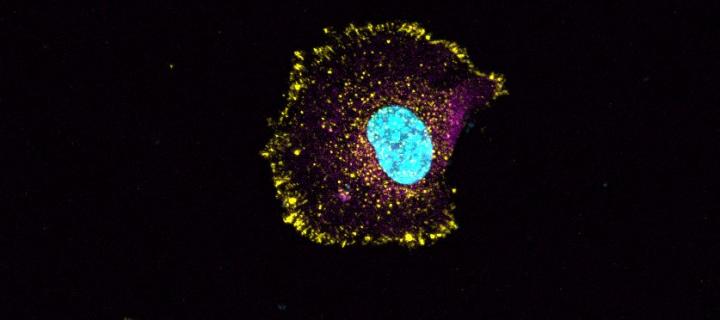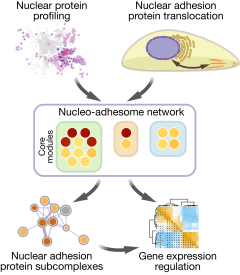Characterisation of a nucleo-adhesome
A study by Edinburgh scientists provides important new information on the ability of cell adhesion molecules to relocate to the cell nucleus: June 2022


When you inspect a eukaryotic cell under a microscope, the nucleus is one of the most obvious parts. It contains the cell’s genetic material (also known as the genome) and is a site for genetic transcription, allowing precise regulation of gene expression – the process by which the instructions in DNA are converted into a functional product, such as a protein. Sophisticated regulation of gene expression enables a single cell with a single genome to produce a large number of descendant cells with very different characteristics. A great example of this is human embryogenesis, where a single fertilised egg cell is able to produce millions of cells as diverse as neurons, skin cells and muscle cells. Abnormalities in gene expression are often associated with serious diseases, including cancer.
Cell adhesion is the process by which cells interact with and attach to neighbouring cells or their nearby surroundings (the so-called extracellular matrix). This is mediated through specialised molecules at the cell surface. These adhesion molecules (collectively termed the adhesome) group together at points of cell adhesion, forming sophisticated multi-molecular complexes which are essential for physiological functions of cells within tissues. Adhesion molecules are connected to multiple signal communication pathways within cells, so these cell–cell and cell–matrix interactions are vital for many biological processes, such as cell survival, differentiation and migration.
For a long time it was believed that there is not much interplay between proteins regulating nuclear functions and cell adhesion proteins. Recent evidence, however, strongly suggests that some cell adhesion proteins can relocate to the nucleus and play important roles in controlling gene expression. For example, Edinburgh researchers demonstrated that Focal Adhesion Kinase (FAK), a protein involved in regulation of the cytoskeleton and assembly of some adhesion sites, can control expression of important genes and, through this process, help cancer cells to evade anti-tumour immunity (Cell. 2015,163:160-73; Sci Signal. 2017,10:eaan8355; Sci Rep. 2021,11:229). Nonetheless, the true extent of nuclear localisation and nuclear functions of adhesion proteins remain largely unknown.
In a recent study, published in the journal Nature Communications and titled “Characterisation of a nucleo-adhesome”, the Edinburgh team combined cutting-edge cell fractionation methods with high-end protein analysis technologies (proteomics) and protein network investigations to characterise a nucleo-adhesome – a set of proteins that can be found both at the cell adhesion sites and in the nucleus – in squamous cell carcinoma cells (a form of skin cancer). Surprisingly, more than half of proteins found in the so-called consensus adhesome (a core set of 60 frequently identified adhesion proteins) were shown to localise to the nucleus. The data provide a strong foundation for developing a better understanding of the extent and functions of nucleo-adhesome proteins. The authors also showed that nuclear FAK transcriptionally regulates the expression of a subset of adhesion proteins that can localise to the nucleus, and demonstrated that nuclear adhesion proteins can co-associate and co-regulate a subset of genes via transcription, further emphasising the role cell adhesion proteins can play in the regulation of gene expression.
The work was led by Dr Adam Byron and Prof Margaret Frame from the Institute of Genetics and Cancer at the University of Edinburgh. It was funded by Cancer Research UK and supported by the Wellcome Trust.
We found that an unexpectedly large number of adhesion proteins are also found in the nucleus. We made this discovery by cataloguing the molecular make-up of nuclei from skin cancer cells. This gives us a new level of understanding of the remarkable extent to which this family of molecules relocates to the genetic control centre of the cell. What these molecules are collectively doing in the nucleus remains to be discovered, but we show in this study for the first time that multiple adhesion proteins can work together in the nucleus to switch on genes in cancer cells. This new understanding of cell biology opens the door to finding new ways that cells control their genes, and this is a valuable starting point for figuring out if – and how – these features go awry in cancer.
Related Links
Article in Nature Communications:
https://www.nature.com/articles/s41467-022-30556-5
Professor Margaret Frame group website:
https://www.ed.ac.uk/cancer-centre/research/frame-group
Adhesion protein networks reveal functions proximal and distal to cell-matrix contacts – expert review:
https://www.sciencedirect.com/science/article/pii/S0955067416300205
Cell Junction, Cell Adhesion and The Extracellular Matrix – interesting YouTube video for non-experts:
https://www.youtube.com/watch?v=ElDO-mnswlM
Related Stories
- Focal Adhesion Kinase controls transcription via chromatin accessibility
- Cancer immune evasion research on the cover of Science Signaling
- Focal Adhesion Kinase activation on lipid membranes
- Synergistic anticancer inhibitor combination discovered by a novel phenotypic screen
- Cancer Centre scientists link cellular trafficking networks to cancer cell invasion

